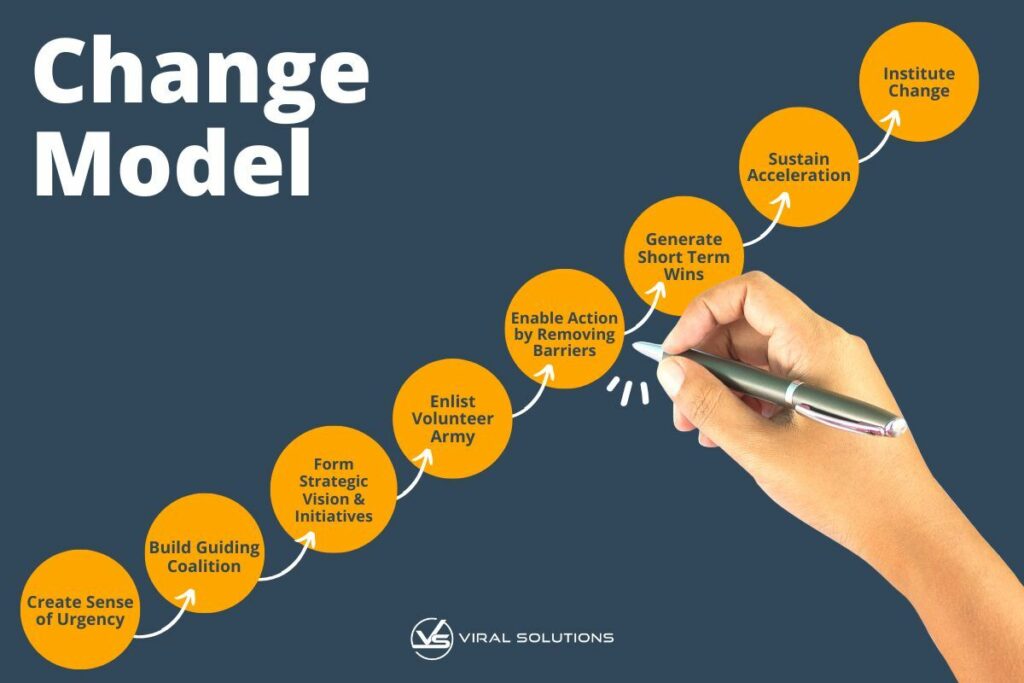
Change Management Process – Step 7: Sustain Acceleration
Jack Welch, the former CEO of General Electric, once stated that “an organization’s ability to learn, and translate that learning into action rapidly, is the ultimate competitive advantage.” In the same way, successful organizational change requires a business to sustain acceleration.
In previous blogs, we’ve discussed the first 6 steps of change management. We now direct our attention to Step 7 of Dr. John Kotter’s change management (CMP) process—sustaining acceleration.
The purpose of this post is to discuss the what, why, and how change management professionals can put this principle into practice.
Recap of Steps 1 to 6 of the Change Management Process
If you’ve been following the previous posts, you know that each phase of the 8-step CMP builds upon another. But before we discuss what it means to sustain acceleration, let’s summarize the previous steps. Links are included to each blog just in case you missed a crucial step or want to refresh your memory.
Step 1: Create a Sense of Urgency
A sense of urgency is the action required to present the need for change. Proposed change can be challenging. By nature, people do not like change, especially when it takes them out of their comfort zones or disrupts their habits.
Creating a sense of urgency establishes that the current system, product, service, or whatever needs to change is no longer the best option. As such, urgency must be established to stop such action.
But urgency also requires leaders to identify and acknowledge respect for the efforts of those who are responsible for the current situation.
Step 2: Build a Guiding Coalition
The second step of the CMP is to build a guiding coalition. According to Dr. Kotter, a guiding coalition is a group of individuals within an organization who are the change initiative’s social leaders.
These individuals bring expertise, energy, and perspective across various areas, and peers respect their professionalism.
Step 3: Form Strategic Vision and Initiatives
According to Dr. Kotter, every successful change management project has a clear change vision.
The change vision is:
- What the organization, department, product, or service will look like after the specific changes have occurred
- The picture of the desired state the change will bring to the organization.
The strategic vision and change initiatives connect the essential steps and actions that need to happen to make the outcome a reality.
Step 4: Enlist a Volunteer Army
A volunteer army is a group of identified peers across a variety of levels in the organization. This group wants to be a part of the initiative to get others in the organization to see the value and act upon the urgency.
Step 5: Enable Actions by Removing Barriers
Enabling action by removing barriers requires knowing exactly what the barriers are and the impact of such restrictions.
The identification of barriers may be completed by leadership, the guiding coalition, or the army of enlisted volunteers, who also help to carry out the initiatives.
Step 6: Generate Short-Term Wins
Dr. Kotter described a short-term win as a milestone or event that the entire team would agree is “huge” and contributes to the fruition of the change vision.
Although this is Step 6, the identification process of short-term wins can start simultaneously with Step 1. Short-term wins can progress throughout each phase of the CMP.
Now that you’re all caught up, we can move on to Step 7, which is to sustain acceleration.
What Does It Mean to Sustain Acceleration?

In the context of change management, to sustain acceleration is to keep the momentum moving forward.
This stage assumes that change management practitioners have moved through stages 1-6 and are making traction in implementing change. The idea is that the initiatives are implemented, barriers are removed, actions are enabled, and short-term wins are celebrated. Therefore, this stage is about building upon previous efforts to ensure the change will last.
Why Is It Essential to Sustain Acceleration?
If acceleration is not maintained, management professionals will experience setbacks, barriers, and other resistors that would minimize the effectiveness of the initiatives.
Simply put, not sustaining acceleration would be wasteful, reckless, and downright misguided.
At this point in the CMP, management has invested significant resources. To disregard the initiatives, environment, and performance would blatantly derail maintaining the key actions needed to cultivate the change vision.
Therefore, sustaining acceleration is paramount to reinforce and maintain the practices, policies, systems, and environment needed to make the change vision achieve and maintain permanency.
This stage is essential to the next and final stage of the change management process, which is to institute change.
Identify Obstacles to Change
Dr. Kotter suggests that at this stage of the CMP, practitioners identify issues within the organizational structure or culture that may impede the change from achieving fruition.
He says that change is fragile until it is properly established. Until a new equilibrium is reached, there is a danger of slipping back to how things were done before the change process started.
Some common reasons that change projects may lose momentum include the following:
Loss of Focus
While the change vision may have been clear near the beginning of the process, it is easy to lose sight of it over time.
If leaders do not keep reminding themselves of the change vision and reiterate it to all the stakeholders, it is easy to lose sight of the final goal.
There will be a loss of urgency as other problems and priorities arise and appear more important. These distractions from the change vision may cause people to lose a sense of purpose and derail the whole process.
Bureaucracy and Organizational Structure
Any organization or business has entrenched ways of doing things that may hinder change. They also rely on a complex web of interdependencies. In order for one section or department to achieve an objective, they depend on others to complete their tasks first. These interdependencies will need reorganization if the business is to operate effectively. If obsolete interrelationships aren’t removed, they can create a drag on the momentum for change.
Complacency
Complacency is the enemy of innovation. Celebrating short-term wins helps to sustain momentum by motivating stakeholders and increasing morale during the long road to change. But declaring the mission accomplished too early can lead to a sense of complacency. It can also embolden detractors if progress begins to backslide.
Poor Morale
The earliest changes may have been the easiest to make but have not altered the fundamental ways of doing things. Making these fundamental changes to culture and introducing new systems may require more resolve when initial enthusiasm is waning. Moreover, turnover and exhaustion can mean losing charismatic and enthusiastic change leaders and lead to burnout for others.
Continuing Resistance
Those who benefit or feel more comfortable with the status quo may still be around, even if they are not as vocal. They may have felt pressure to stop resisting change in the short term. But with time, they may reassert their passive or active resistance to change. This is another reason leaders must stay vigilant and maintain a sense of urgency.
How Can Change Management Practitioners Sustain Acceleration?
After identifying the roadblocks to change, management professionals should take the following actions recommended by Dr. Kotter to sustain acceleration.
Reorganize and Remove Barriers to Change
Leaders and managers must ensure that policies, procedures, systems, and such align with the overall change vision. If there are inconsistencies that do not align with the change vision, they must design ones that do.
This includes replacing interdependencies that no longer serve the organization and replacing these obsolete linkages with ones that enable it to operate effectively.
Maintain Momentum
Change managers may want to introduce strategies to reenergize the process with new projects, coalitions, and themes that support sustaining the initiatives and change vision.
Stay on Message
To sustain acceleration, leaders, with the help of change managers and the army of volunteers, must keep focused on the change vision and remind stakeholders why organizational changes are necessary.
Reinforcing the urgency to continue the change process will help motivate the workforce to overcome challenges to any transition. It is, therefore, important to celebrate the small changes and build credibility by bringing attention to the improvements achieved so far—without allowing complacency to creep in.
Refresh the Team

Change management practitioners may consider hiring, promoting, and developing employees to continue implementing the change vision.
Bringing in people with fresh ideas and enthusiasm to replace those who are worn out or have left the company will help to bring a new spirit to the project and improve morale.
Evaluate Progress
Evaluating the key initiatives and actions to keep your team on the path to reaching your changing vision is essential. In addition, this will help maintain a realistic perspective of progress.
Takeaway
Step 7: Sustain Acceleration is the second-to-last stage of the CMP and builds upon the previous steps.
The purpose of sustaining acceleration is to maintain speed and ensure the quality of the outcome. To achieve this, it is necessary to identify, implement, and monitor key strategic initiatives, practices, and systems needed. It also allows managers to identify the people who will carry out the change visions.
As such, proactive management is essential to ensure that such principles are put into practice.
The weaker the practice, the less acceleration of sustaining the change vision and the greater risk of reverting to previous practices that do not align with the desired change outcomes.
Therefore, the objective of maintaining acceleration is to aid in reinforcing the efforts made in previous stages and building upon the next stage of the change management process, Step 8: Institute Change.
For more information or to discuss strategies your firm can use to sustain change initiative practices within your marketing efforts, reach out to our team at Viral Solutions. We’ll be more than happy to help you connect principle to practice.
Read the final post in the series, Step 8: Institute Change.


